Chris Sims's Blog, page 2
October 14, 2010
Mutate Your Game
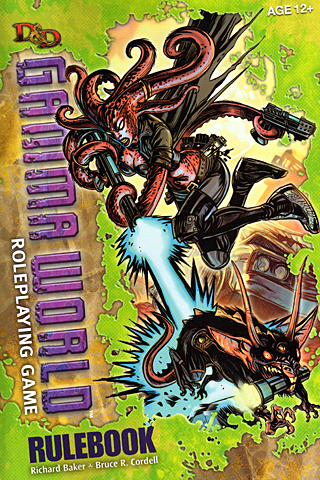 A lot has been made of the fact that you can "reskin" game elements in the D&D game to make what you want. Reskinning just means taking a mechanical element and changing it cosmetically or in minor mechanical ways, as DM approved, to make it fit your character concept. From James Wyatt's great sidebar "My Son the Fire Archon" in Dungeon Master's Guide 2 (page 21) to Jeff Greiner's and my little bit on The Tome Show 138, reskinning has definitely been in the air.
A lot has been made of the fact that you can "reskin" game elements in the D&D game to make what you want. Reskinning just means taking a mechanical element and changing it cosmetically or in minor mechanical ways, as DM approved, to make it fit your character concept. From James Wyatt's great sidebar "My Son the Fire Archon" in Dungeon Master's Guide 2 (page 21) to Jeff Greiner's and my little bit on The Tome Show 138, reskinning has definitely been in the air.
I have wondered why more people don't do it. Then I realized that it isn't all that easy. Experienced players and DMs might think it is, but reskinning is more than just an exercise in creativity and imagination. Required is a willingness to experiment and to face the possibility that your experiment won't work. It's reasonable to be uncomfortable with that type of experimentation when you're just learning a game or you're unfamiliar with the game's boundaries.
Examples serve to an extent. James's sidebar is a fine case in point. Any number of examples are just that, though, until you do it. You have to reskin something to know what it's like, and then you have to use that element to see how it works for you.
Well, the new D&D Gamma World game is a freaking (emphasis on that) crash course on reskinning. Character creation, from concept to equipment, is a real-world exercise in putting your imagination's images over a mechanical chassis in a simple game. Sections in the rules cover the process, from the "Reconciling Contrary Origins" segment to the "What Does it Look Like?" sidebar on equipment.
The awesome thing is that so many of these parts are directly interchangeable. Character origins, which every character has two of, combine to make unique mutants and humans that you create from your imagination based on the mechanical information you're given. Cooler still is that each origin provides features and powers at the same levels, so it's easy to imagine swapping these mechanical elements between origins to make a character that's even more customized to your vision.
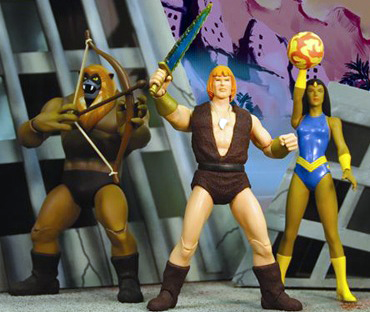 Mutant Child
Mutant ChildI was enamored with the D&D game from the first moments I played it. Brave warriors and mighty sorcerers fighting dragons? Yes, please. More, please.
I imagine that a lot of us longtime D&D fans are similar in that our fandom for the game quickly spread to fantasy and sci-fi of other types. I devoured anything I could that seemed even remotely like D&D and stole it for my game.
That's really another topic, but it brings me to the point that I liked the show Thundarr the Barbarian when I was a kid. It came out before I owned my own D&D set, but not before I played the game. And it was in syndication for a while after that, so you could catch episodes. I hear you still can on Cartoon Network from time to time.
The Thundarr show had the coolest intro for a a 9-year-old D&D-nut kid. In fact, that intro isn't bad entertainment fiction today:
The year: 1994. From out of space comes a runaway planet, hurtling between the Earth and the Moon, unleashing cosmic destruction! Man's civilization is cast in ruin! Two thousand years later, Earth is reborn. A strange new world rises from the old: a world of savagery, super science, and sorcery. But one man bursts his bonds to fight for justice! With his companions Ookla the Mok and Princess Ariel, he pits his strength, his courage, and his fabulous Sunsword against the forces of evil. He is Thundarr, the Barbarian!
Back then, this was cool D&D stuff, since it was before I was exposed to the Gamma World game. Today, I catch Thundarr's similarities to Conan and classic characters such as John Carter of Mars. Thundarr's was a post-apocalyptic world full of old technology, bizarre creatures, and weird magic. It's still great D&D stuff, but it's fantastic D&D Gamma World stuff.
This recently got me thinking that if the current Gamma World is so good for reskinning, I should be able to put it through its paces in reverse. Yeah, it's not lost on me that I'm imposing something on a system that more freeform. It's also clear I'm just giving more reskinning examples. Let's just pretend this is proof of concept rather than me reliving some of my childhood fantasies. When you get your hands on Gamma World, you can tell me how well I did.
 Thundarr is clearly human, and he's an ex-slave warrior with simple drives. See, he is a post-apocalyptic Conan. If I were going to make up Thundarr as a D&D Gamma World character, I'd take the Engineered Human (swap Intelligence for Strength) origin and mix it with Hypercognitive. I'd roleplay Hypercognitive as less psionic "I see the future" and more "I'm so good at combat, I see what's coming and react instinctively." Thundarr uses his fists and his fabulous Sunsword, which is clearly a piece of (Ishtar) Omega Tech Thundarr has salvaged, probably with Princess Ariel's (see below) help.
Thundarr is clearly human, and he's an ex-slave warrior with simple drives. See, he is a post-apocalyptic Conan. If I were going to make up Thundarr as a D&D Gamma World character, I'd take the Engineered Human (swap Intelligence for Strength) origin and mix it with Hypercognitive. I'd roleplay Hypercognitive as less psionic "I see the future" and more "I'm so good at combat, I see what's coming and react instinctively." Thundarr uses his fists and his fabulous Sunsword, which is clearly a piece of (Ishtar) Omega Tech Thundarr has salvaged, probably with Princess Ariel's (see below) help.
Ookla the Mok is Thundarr's buddy, kind of like if Conan had a wookie sidekick. Thundarr and Ookla escaped slavery with the help of their other ally, Princess Ariel. The moks are feline in derivation, and they're big and strong, so Ookla is easy. He could be Felinoid (if we want Dexterity instead of a focus on Strength) or Yeti for his first origin, then I'd use the Giant origin for Ookla's immense strength and great size. Ookla opts for nontechnological weapons, such as bows (see, Dexterity), clubs, and whatever he rips out of the ground or off the wall . . . like a lamp post or 400-pound gargoyle.
Princess Ariel, stepdaughter to the evil wizard Sabian who enslaved Thundarr, is harder. She's a sorceress with great knowledge of Earth's past. Since Ariel looks human, we could start with Engineered Human. Ariel can do plenty with her magic, though, and she rarely used any weapon. Maybe a better model is Telekenetic plus Mind Breaker. Those origins give Ariel a good potential array of powers and skill bonuses that make sense. To reinforce her human appearance and lack of constant telepathy, I'd swap in the Engineered Human origin's Tech Affinity in and lose the Mind Breaker's Group Telepathy feature.
Ariel also got me thinking that one could use a D&D character in Gamma World ala Thundarr. Ariel is likely to be a D&D Essentials mage specializing in evocation. It'd be fairer, though, and maybe more interesting, if the DM and player worked together to give Ariel her sorcery by paring down the evoker into an origin-like format. I haven't done that . . . yet.
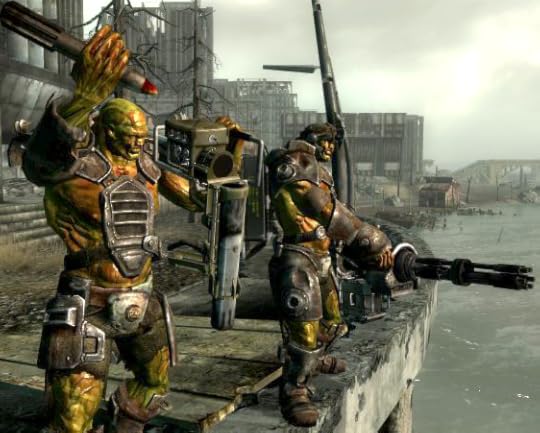 Adult Fallout
Adult FalloutAs you might know, I really like Fallout 3. How can I think about the D&D Gamma World game without thinking about Fallout 3? You're right, I can't. Besides, I've thought about using the Fallout setting with Gamma World for a long time, and I've read of others having the same thoughts.
Gamma Terra, Gamma World's setting, and the world of Fallout are very different, but who cares. I say embrace the strengths of both. Steal from Fallout to make your Gamma Terra better. Fallout kind of has the same spirit as Gamma World, anyhow. It's post-apocalyptic ruination with a dash of the absurd. Gamma World just takes the far-out a little further out, that's all.
As an aside, I strongly advocate the idea presented in the Gamma World rulebook that you set your first campaign in your home town. The juxtaposition of the familiar with the wonderfully bizarre realities of Gamma Terra is just too priceless an opportunity to pass up. That doesn't mean you can't loot Fallout for ideas. You should.
When I was thinking of reskinning plunder from Fallout for Gamma World, my mind went to two races prevalent in the Fallout setting: super mutants and ghouls. I'd want both to be monsters, sure, but I'd also want them available to players. The unusually sane super mutant and nonferal ghoul are great character concepts that Fallout 3 itself uses.
Super mutants are actually easy to model. They're giant asexual humans with radiation immunity. That means if you mix the Engineered Human (swap Intelligence for Constitution) origin and Giant origin, you arrive at a good base. I'd then lose the human Skill Bonus and Tech Affinity features and replace them with the Radioactive origin's Skill Bonus and Gamma Tolerance features. I might also replace the human's expert power with the Seismic origin's expert power. Done.
Ghouls require a little more tinkering. I'd still start with Engineered Human, then I'd throw in Android, playing on the idea that ghouls are created, not born. Again, I'd replace the Engineered Human Skill Bonus and Tech Affinity features with the Radioactive origin's Skill Bonus and Gamma Tolerance features. I'd rework the Android origin powers to fit the semiliving ghoul form, and I'd replace the Machine Powered Android feature with Two Possibilities from the Doppelganger origin. It just makes sense to me that Gamma Terra ghouls might have more alpha flux given that they were made "undead" by super doses of radiation.
 Go Flux Yourself
Go Flux YourselfMuch like I was sold on my first D&D game as a kid, I have been sold on the D&D Gamma World game since my very first playtest. Rich Baker and Bruce Cordell hit one out of the park with this game, and I can only hope future supplements live up to this high standard. The potential for amusement within the book and related cards cannot be described adequately in print. Everyone in the room laughed enough to have tears in their eyes the first time I played, and the laughing started during character creation. It's not a serious roleplaying venture, but it is fun. Try it at least, since Gamma World Game Day is coming up. I doubt you'll be sorry, even if your character is eaten by a yexil or dissolved by radioactive slime. If you need some more incentive, Dave the Game has a thing or two to tell you, as does Penny Arcade (click through News for more from Gabe).

October 7, 2010
Do the Evolution
I realize I could be a little dated. I mean I'm 38 going on 39 the day before Samhain starts. My supposed heyday was about the same time as that of Grunge. (Hence the title of this piece.) Back then, the Dark Sun Campaign Setting (boxed set!) was also the new hotness for the D&D game, and the SSI video games based on it were bleeding edge. (Man, I wish a new Dark Sun video game was coming out for PC or consoles.)
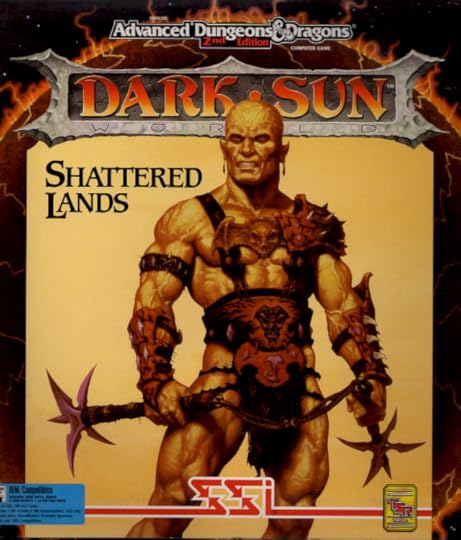 My age, and the fact that I feel life gets better and better, got me thinking about the ways things change. Specifically, I've been thinking about the way games change.
My age, and the fact that I feel life gets better and better, got me thinking about the ways things change. Specifically, I've been thinking about the way games change.
I started my history with gaming, I realize now, with the D&D Basic Set in 1981. I got the red box, and my twin, Neil, got the blue box—the Cook Expert Set. At the time, neither of us realized that the AD&D game was out there in all its hardbound glory.
We soon rectified that oversight. With our pocket money for doing chores, we bought AD&D books. Despite the fact that we had those hardcover tomes, the boxed sets really shaped the way we played. Sure, we used the advanced rules, but we routed around convoluted bits and anything that was more work than fun.
As the years rolled, and because we had overzealous Christian parents who did away with our D&D stuff, my brother and I expanded our gaming taste. We played the original Palladium Roleplaying Game, Car Wars, Gamma World (Second Edition among others), the first Star Frontiers (dralasites rule), Marvel Superheroes (FASERIP version), and more. I even fooled around with games such as Powers & Perils (now free online), although I couldn't get others to play it. We later moved on to games such as Rolemaster, GURPS, and the original Shadowrun, as well as the first Vampire the Masquerade and its World of Darkness descendants. (Mage the Ascension, played with GURPS rules, is still among my favorites.) Other D&D grandchildren followed for me, such as Arcana Unearthed (new Evolved) and Mutants & Masterminds.
My time on this planet has allowed me to explore all sorts of games. I played computer games such as Adventure, Venture, Temple of Apshai, The Bard's Tale, and so on, up to modern games such as Fallout 3 and Dragon Age. Working among a fine gaggle of geeks has allowed me to learn other games, such as Savage Worlds. I've also dabbled in indie roleplaying games such as 3:16 Carnage Amongst the Stars and Fiasco.
What I never gave much thought to when I was younger but amazes me now is that all these games owe their existence to the D&D game. All of them, including those companies other than TSR produced, are evolutionary offshoots of the original D&D game. D&D itself is an evolution of even older forms of wargaming, such as Little Wars and Floor Games by none other than H.G. Wells.
RPGs as Organisms
What if we imagine the original D&D game as the evolutionary link between wargaming and modern roleplaying games of all sorts? I looked again at the basics of evolution before I wrote this, and it seems very relevant. Every derivative game has some part of the original, signs of its ancestry. Like with organisms, variations from the original are introduced in the process of creating a game. Further, more game "offspring" tend to be produced than the gaming environment can support. Traits that ensure survival in a given environment become more common in descendants.
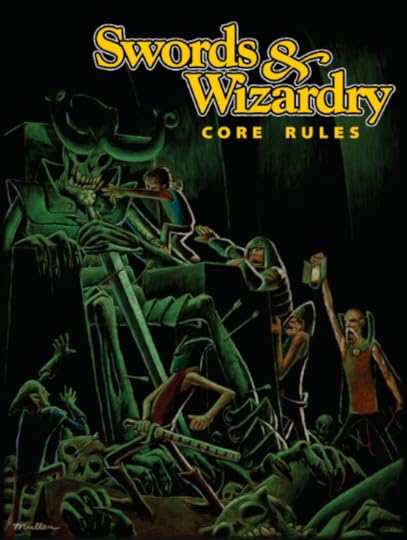 The long and short of all this is that a game cannot remain the same over successive generations in a changing marketplace and hope to survive. It might be able to carry on in limited numbers in isolated ideal environments, the way OD&D still survives among groups who play and love it. If old-school D&D is enjoying a renaissance, that revival is because the game has adapted to the modern gaming environment in important ways. Swords & Wizardry, as just an example, is not the OD&D game—it's a new animal derived from the old, built to be accessible and free for the new gaming jungle. Still, it lives and breathes only in a carefully cultivated milieu.
The long and short of all this is that a game cannot remain the same over successive generations in a changing marketplace and hope to survive. It might be able to carry on in limited numbers in isolated ideal environments, the way OD&D still survives among groups who play and love it. If old-school D&D is enjoying a renaissance, that revival is because the game has adapted to the modern gaming environment in important ways. Swords & Wizardry, as just an example, is not the OD&D game—it's a new animal derived from the old, built to be accessible and free for the new gaming jungle. Still, it lives and breathes only in a carefully cultivated milieu.
To thrive, a game system has to reach its prey, us gamers, and keep us interested. It has to be accessible for new players, yet keep a level of complexity for the seasoned user. It also has to innovate and entertain, this last point based on those among us who read but rarely, if ever, play. (I read tons of games I never played, such as Star Wars d6, TORG, RIFTS, and more.)
The D&D game and its offspring of the same name have always been in a state of evolution, trying to keep up with the changing environment. At times, it evolved too slowly, and although it remained the most widely known of roleplaying games, it almost went extinct. AD&D Second Edition came about ten years after the original, and the D&D 3e came more than a decade after that. (4e came about 8 years later.) We were graced with the third edition only because some folks who loved the game helped carry on its legacy. D&D's diverse descendants almost had to go on without it, and they would have, like any organism does, and might have lived better without their ancestor. (That's a big maybe that's also another topic.)
Those descendants changed more rapidly. Shadowrun, for instance, has had five editions in twenty years if you count the most recent 20th anniversary edition. GURPS has had five editions in twenty-five years if you count Man to Man. (The Fantasy Trip might make six versions of GURPS in thirty years, if you're willing to make allowances. It's still available.) Vampire: The Masquerade had four revisions in thirteen years. Mutants & Masterminds has had a new version every few years—it was released in 2002 and the third edition is coming this fall (scroll to May 12th).
Game evolution, though, is actually much more rapid than versions of a core game might suggest. Every supplement changes the game. Each sourcebook attempts to adapt the game to its environment and keep the game fresh and young. When system overhauls occur, they're often based on reasonable forces that call for an improvement. Not the least among these is audience use and feedback, which is easier to come by today than ever before.
 Long Live Evolution
Long Live EvolutionThe D&D Essentials line might be taken to be a revision of the edition, but to me, it feels more like regular old evolution than any normal revision does. Essentials takes its legacy and tries to thrive in a fresh way. Characters in Essentials can use earlier materials, and non-Essentials characters can play right alongside their newer counterparts. That's unlike many game system revisions, and nothing like the update from 3e to 3.5.
The Pathfinder game is a more significant system evolution from 3.5 than the Essentials line is to 4e. Preexisting classes receive a working over in Pathfinder in ways that can make past 3.5 materials incompatible or at least in need of serious scrutiny. Changes to these and other aspects of the game can be significant enough that you have to pay attention when using older D&D material.
That fact doesn't bother me in the slightest, though. Pathfinder is a product of an honest process of evolution, too. It takes hereditary material, gives it a good shake to see what works for the modern environment, and then gives survival a sincere go. Nothing is wrong with that.
If we acknowledge game supplements and updates as part of the evolutionary process, a lot of our games—D&D, Pathfinder, Fiasco, Savage Worlds, and so on—are always evolving. The truth is, and if you're honest I'll bet you'll admit it, we gamers like it that way. In all sorts of games, from the latest Shadowrun sourcebook to the newest Fable video-game release (this month!), we gamers want new stuff to think about, to talk about, and to play with.
My inner fanboy loves game evolution. I express my love by trying out some new games now and then, although admittedly, more and more are electronic games. (Something is to be said for ease and speed of access and play.) Further, I do so by buying a few and even playing a few on an irregular basis. In your way, I'm sure you like game evolution, too, and you put your money where your heart is. Can you fault another gamer for doing the same? It just seems silly to decry another's evolutionary path when you have your own.
Thunderdome!
I've decided to put my money where my . . . keyboard is. I want to play more games with my fellow gamers. My aim is to expand my horizons and to witness more game evolution. I'll admit I'm going to favor games I think I might like, but that's natural. I'm also going to favor games I can play in real time and space rather than virtual, at least for the first part of my trial. My aim is to have fun with potential new friends.

Cameron McNary came up with the title, or I did after failing to completely understand a series of tweets from him. The point is: If you live in the Washington State area and might want to play a game with me sometime, send me an email at the address in my bio below. Include the Thunderdome in the subject, and tell me what you want to run or play.
I'm no Keith Baker with "Have Dice Will Travel." What I am is willing to do a little roving with my dice, and I might end up in other areas from time to time, such as Virginia and the upcoming NanoCon. I'm also willing to help in a little reaving by running D&D 4e or the new Gamma World occasionally.
I'll keep you posted on twitter and here. 'Til next time, I'm out.

September 23, 2010
Loss Builds Character
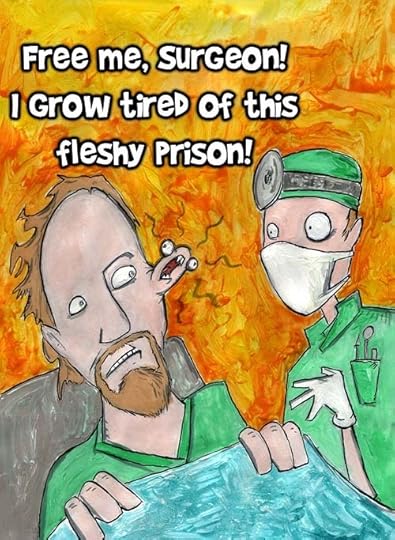 I've experienced a bit of loss recently. I lost my job at Wizards of the Coast this past December. No permanent employment has come my way yet, so I could lose my house. (Maybe not such a bad thing, all considered.) I gave my pound of flesh to the surgeon who removed my little cancerous growth. (Shaking my fist at the sun, I know it's really my fault.) I lost my sister this past month. Heck, I've even lost over thirty pounds, taking the good with the bad. Loss has been on my mind a lot...
I've experienced a bit of loss recently. I lost my job at Wizards of the Coast this past December. No permanent employment has come my way yet, so I could lose my house. (Maybe not such a bad thing, all considered.) I gave my pound of flesh to the surgeon who removed my little cancerous growth. (Shaking my fist at the sun, I know it's really my fault.) I lost my sister this past month. Heck, I've even lost over thirty pounds, taking the good with the bad. Loss has been on my mind a lot...
September 9, 2010
The PAX Report
I had a great time at PAX. Here are some high points of my trip to the show. (Click on the pics for bigger and better.)

Thadeous!
Thursday Night Fight
For pre-PAX fun, I gathered with some friends to play my Welcome to Dark Sun game. Players included such inimitable rowdies as Adam Wojtowecz, Brian James (The Grand History of the Realms, Demonomicon), Derek Guder, Erik Scott de Bie, Matt James, and Thadeous Cooper. Taking some tips from ChattyDM, I started at a different point than I began my ...
September 2, 2010
Minions on the Table
In my last miniony article, I wrote about tinkering with minions mechanically to come to the flavor you really want from them. Now it's time for your minions to meet the consumers, your players. A lot off cooks say that a big part of the experience with food is presentation. It's the same with encounters in general and minions in specific. The tastiest minions might fail if you give them poor table presence.
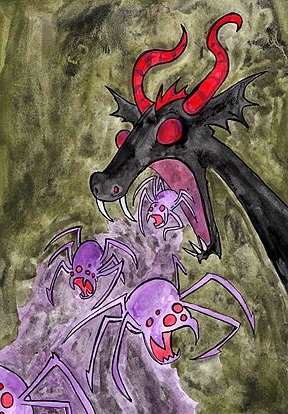 A Nice Spread
A Nice SpreadMonsters can lose a battle before it begins if they have bad tactical...
August 19, 2010
Minions of Differing Flavors
Last time, I talked about how minions spice up encounters and what they're meant to do in the D&D game. But, just like the epicure needs new and exciting experiences, numerous DMs among us need new ways to mix it up with minions. This is especially true if you feel your minions disappear too quickly to be interesting or seem to be no added challenge. I'm going to attempt to, as an infamous chef might say, help you to kick it up a notch . . . sometimes.
I already suggested that you take some...
August 2, 2010
Chris Sims's 2010 Gen Con Schedule

Maybe you'll recognize me . . .
I'm going to Gen Con for the first time as a civilian, and like Chatty DM, for the first time as part of the Critical-Hits team. Here's my planned schedule. We'll see if it survives contact.
Wednesday4:30 PM
I arrive at the convention! I'll be hungry. I hope to see you. I'll be hanging out with as many folks as I can.
8 PM: DD&D with Phil
Location: Tbd, so look for it on Twitter.
I'll be playing Shard in'Nay, shardmind wizard. Audience encouraged!
ThursdayEarly in ...
July 29, 2010
Sunburn is the Least of Your Worries
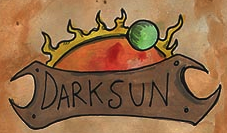 Right now, I'm caught up in general work and Gen Con preparation, and you benefit. I've decided to kill two proverbial birds with one metaphorical stone. I'm using my blogging time to prep for Gen Con! Did I mention you benefit? My minions shall return in a couple weeks.
Right now, I'm caught up in general work and Gen Con preparation, and you benefit. I've decided to kill two proverbial birds with one metaphorical stone. I'm using my blogging time to prep for Gen Con! Did I mention you benefit? My minions shall return in a couple weeks.
At Gen Con this year, I'm running a few D&D game sessions set in Athas. This Dark Sun game, known affectionately as Welcome to Dark Sun, B!#@&s!, is a version of the campaign opener for my Dark Sun playtest campaign that...
July 22, 2010
Minions Are Spice
A minion is a tiny onion used for flavor, especially in soups. That's what my father told me when I was a kid. Even then, though, the D&D game had imparted enough for me to see the lie and the humor. In fact, if analyzed closely, this quip from dear ol' dad, and my assimilation of it, might explain a lot about me. Talk about analysis paralysis.
But that's not why we're here, all thoughts about narcissism and social media aside. No, this isn't about me. It's about our D&D games and the cute...
July 15, 2010
Fiasco, It's Not
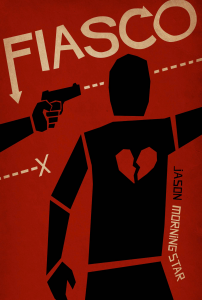 Critical-Hits has run a review of Fiasco and an Origins report that included it, but I'm here to report as a Fiasco player. I played with four other veteran gamers, a few among us industry pros. Logan Bonner got us together and learned the rules with us. For the record, I have read on bits of the Fiasco rules, so this report is purely experiential and relies heavily on my memory of events. I'm also trying out a Chatty DM style post for a change. (Mimicry is flattery, Chatty.)
Critical-Hits has run a review of Fiasco and an Origins report that included it, but I'm here to report as a Fiasco player. I played with four other veteran gamers, a few among us industry pros. Logan Bonner got us together and learned the rules with us. For the record, I have read on bits of the Fiasco rules, so this report is purely experiential and relies heavily on my memory of events. I'm also trying out a Chatty DM style post for a change. (Mimicry is flattery, Chatty.)
First...
Chris Sims's Blog
- Chris Sims's profile
- 22 followers




